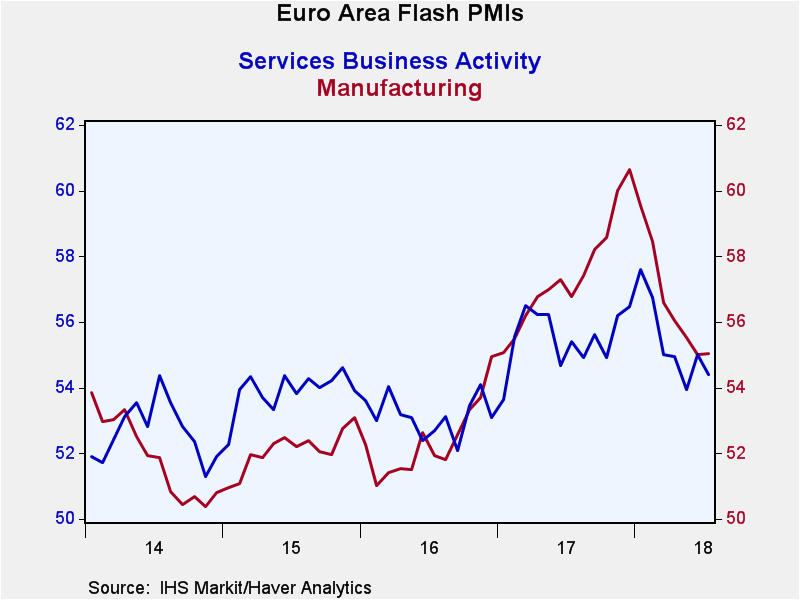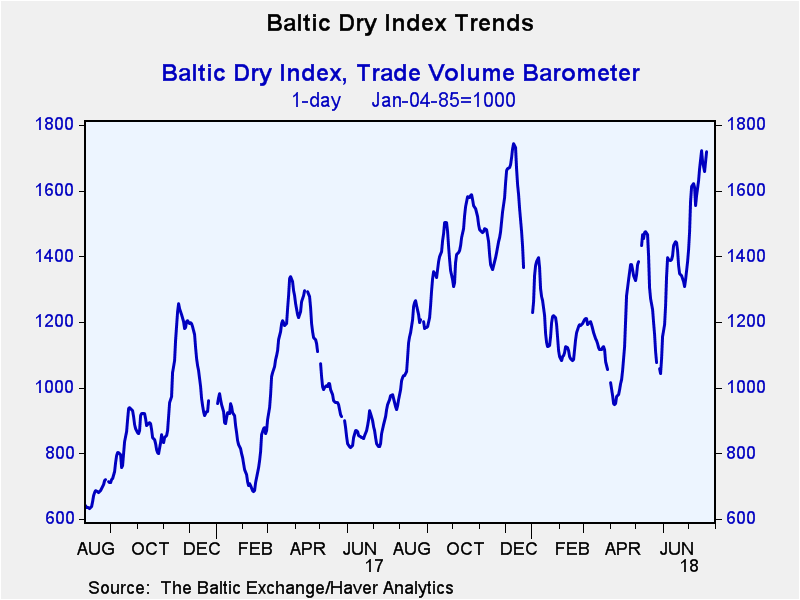 Global| Jul 24 2018
Global| Jul 24 2018EMU and Other Flash PMIs Are Mostly Weaker; The Great PMI Unwind
Summary
It took the EMU manufacturing index 11 months to climb from a diffusion value of 55 up to its peak in December 2017 at 60.6, but then it took only six months to fall to 55 and stay there, now for two months running. In contrast, the [...]
 It took the EMU manufacturing index 11 months to climb from a diffusion value of 55 up to its peak in December 2017 at 60.6, but then it took only six months to fall to 55 and stay there, now for two months running. In contrast, the EMU services gauge moved up from a 2016 low to a 2017 peak then to an even higher peak in January 2018 before engaging in its own unwind. The services gauge is currently off its recent lows but above nearly all its observations for 2017 and well-above its 2015 and 2016 values.
It took the EMU manufacturing index 11 months to climb from a diffusion value of 55 up to its peak in December 2017 at 60.6, but then it took only six months to fall to 55 and stay there, now for two months running. In contrast, the EMU services gauge moved up from a 2016 low to a 2017 peak then to an even higher peak in January 2018 before engaging in its own unwind. The services gauge is currently off its recent lows but above nearly all its observations for 2017 and well-above its 2015 and 2016 values.
Is it the journey or the destination that matters?
A simple glance at the chart tells you that despite these two different paths the manufacturing and services sectors have nearly the same diffusion values and a look at the table shows that their respective queue standings for this period are identical. However, we are left with the impression that manufacturing is and has been under pressure while services have backed off their recent highs and are now moving sideways and more or less stable in a range. However, these are subjective judgements and there is no way to tell what really lies ahead. We can extrapolate trends, but the whole point is that we do not know if that is the right thing to do or not.
Fundamentals, politics and policies- Oh, my!
Fundamentally, both Europe and the global economy are coming to grips with various problems. Recovery is getting long in the tooth as falling or low unemployment rates for labor tell us even if there is little evidence of wage inflation. Some of the ‘special issues’ are pointedly economic like the unfolding trade war with the U.S. that is progressing on various fronts. Or the Iran deal that the U.S. has pulled out of that comes with the threat of economic sanctions or simply the North Korean denuclearization process, the U.K.’s Brexit situation, the ongoing conflict in the Middle East and the migrant problem -- all are examples of ongoing conflict and uncertainty. The ECB has been talking more about ending its accommodative phase while inflation in Germany has rising to what would have been the Bundesbank’s boiling point if it were still making monetary policy for Germany. Angela Merkel is stinging over partisan divisions about migrant treatment in Germany. In France, Macron is facing dissent; Italy has a new government that everyone is watching closely; and Spain has a relatively new government and still has a back-burner issue with Catalan. So... are international issues or local economic or political issues dogging Europe?
 Trade disruption or not?
Trade disruption or not?
While it is important not to downplay the role of expectations in economics, the Baltic dry goods index, a well-respected index of current international trade volume, suggests that trade is not yet disrupted. The recent rise in the index could be the result of enhanced trade flows designed to get in under the wire before trade sanctions bite, except the current rise is nothing exceptional in the history of the index which is readily apparent. Don’t be fooled by the name of the index as it is indeed an index constructed from global shipping patterns and freight rates. I would conclude from this chart that there is little impact from trade disruption in the data to date. But that does not make me unconcerned about the future.
Turning to the PMI data in the table, we find largely eroding patterns for PMIs in Europe for the EMU, German and French gauges. The EMU gauges are in July below their respective three-month average values and below their averages for six-month and for 12-month as well. The German composite index for July is above its three-month average but below its six-month and 12-month averages. The same is true for German manufacturing; German services sit on the same level as their 12-month and six-month averages and above their three-month average. While German services have steadied, they are the weak reading of Europe as things stand (with only limited flash readings available). German services have a 45th percentile queue standing below their historic median. Meanwhile, EMU services and manufacturing have a 67th percentile standing, the same as the French composite, a bit below Germany’s 72.7% standing for manufacturing. All in all, these are moderately firm readings, except for German services.
Japan finds its manufacturing readings lower in July by nearly 1.5 points. That puts its reading below all its sequential averages and places it in its standing in its 38th percentile, well below its historic median.
The U.S. is a bit of mixed case. Its composite PMI is weaker in July than in June but stands even with its three-month average and above its other sequential averages which themselves have been moving higher on a very slow upward path. U.S. manufacturing improved on the month rising to a diffusion reading of 55.5, but that leaves it below its three-month and six-month readings yet above its 12-month average. U.S. services slipped month-to-month, but the gauge is above all of its sequential averages which also are moving steadily higher but at a slow pace. The U.S. readings cluster about percentile standings around the 70th percentile, only marginally stronger than those readings for the EMU.
On balance, there is not much indication of growth or trade flow disruption...yet. Japan may be an exception as its manufacturing gauge is substantially lower on the month. We know that China is pulling all sorts of rabbits out of its hat to try to stimulate its economy for the loss of business that it expects to result from U.S. trade actions and from its own retaliation.
Actions have consequences. Diffusion gauges are sensitive and should be a leading barometer ferreting out trade disruptions when they begin to occur. It would not be surprising if trade effects began to bite in Asia first since Asia is a production center and production is threatened. If consumption is affected in consumer nations like the U.S., that loss in demand will be partly compensated for by lower imports. For export-led growth Asia, expect mostly a dead weight loss from lower output since U.S. exports to them are of minor significance- that’s what this is all about.
The strongest economy in the world, the US, has the export punch of a 98 pound weakling to Asia? On the face of it, it is ridiculous to consider this the result of free or fair trade. It has simply gone on for too long. Economic mechanisms – left untampered with- would have put a stop to it long ago.
Robert Brusca
AuthorMore in Author Profile »Robert A. Brusca is Chief Economist of Fact and Opinion Economics, a consulting firm he founded in Manhattan. He has been an economist on Wall Street for over 25 years. He has visited central banking and large institutional clients in over 30 countries in his career as an economist. Mr. Brusca was a Divisional Research Chief at the Federal Reserve Bank of NY (Chief of the International Financial markets Division), a Fed Watcher at Irving Trust and Chief Economist at Nikko Securities International. He is widely quoted and appears in various media. Mr. Brusca holds an MA and Ph.D. in economics from Michigan State University and a BA in Economics from the University of Michigan. His research pursues his strong interests in non aligned policy economics as well as international economics. FAO Economics’ research targets investors to assist them in making better investment decisions in stocks, bonds and in a variety of international assets. The company does not manage money and has no conflicts in giving economic advice.






